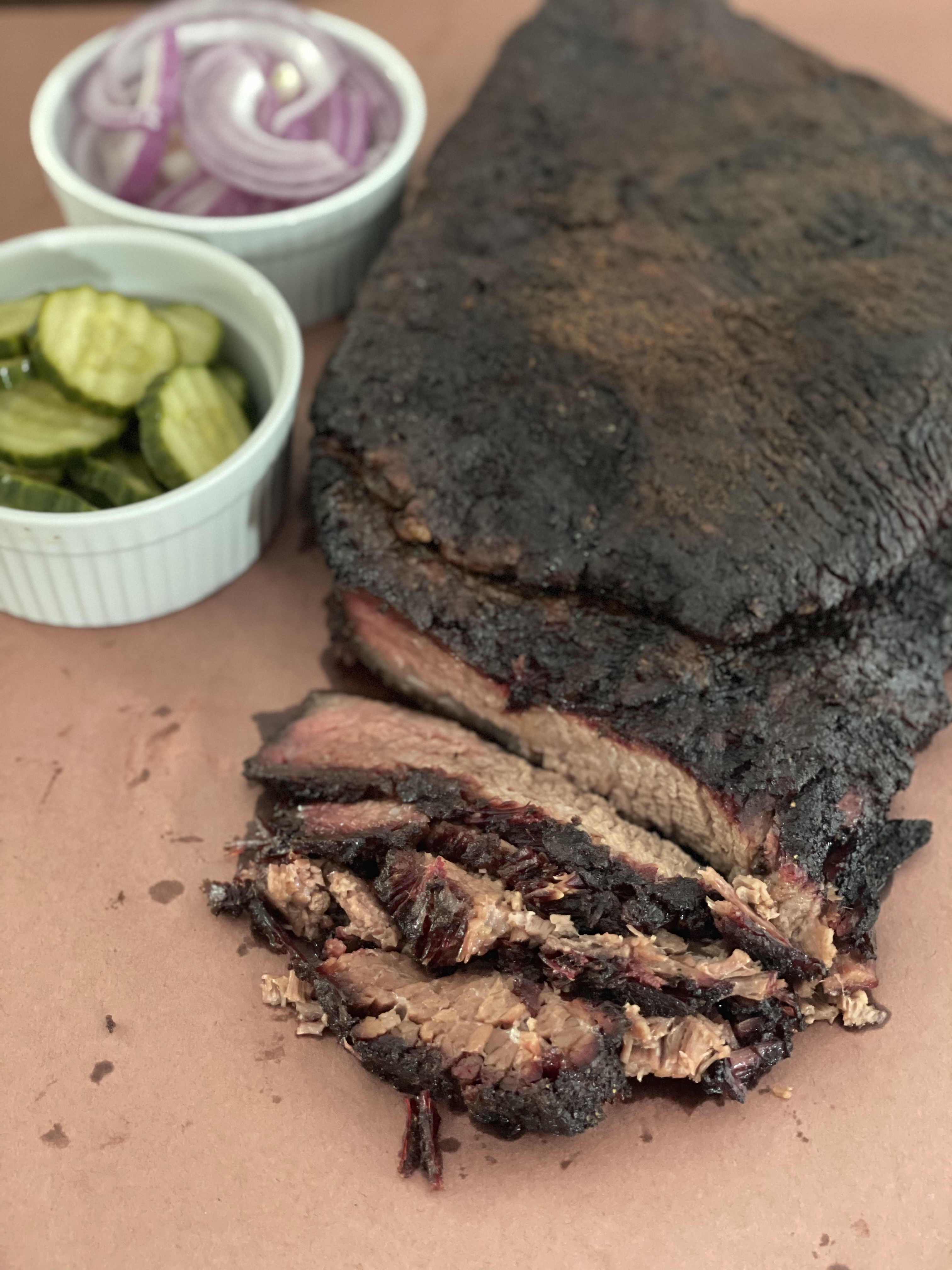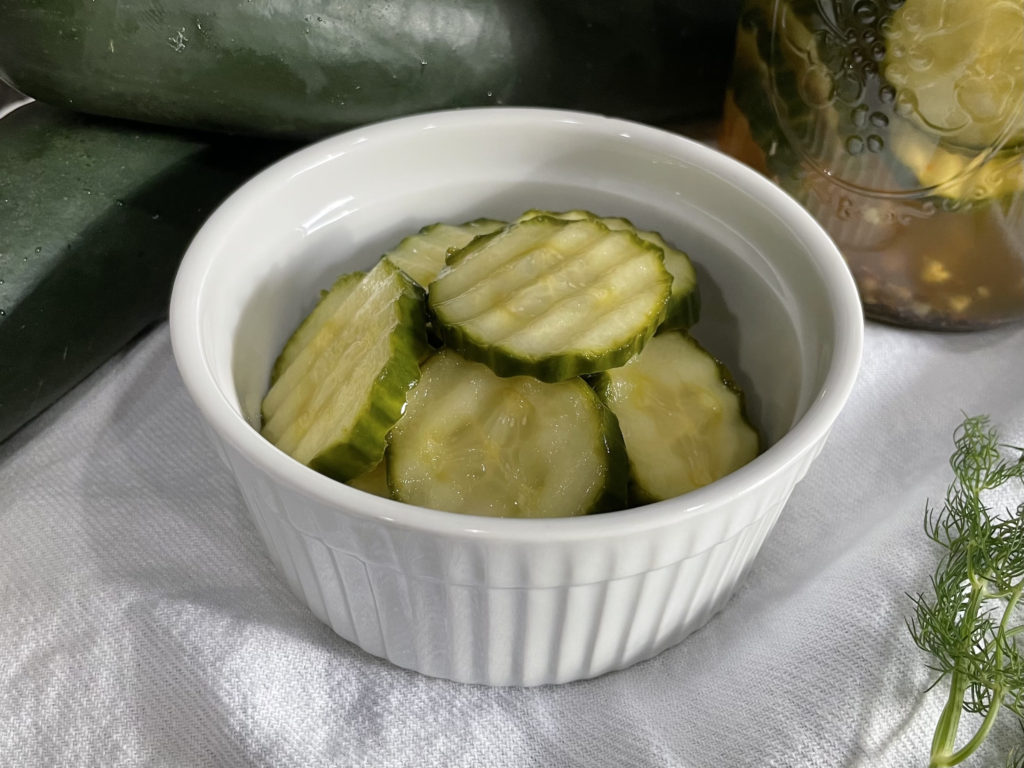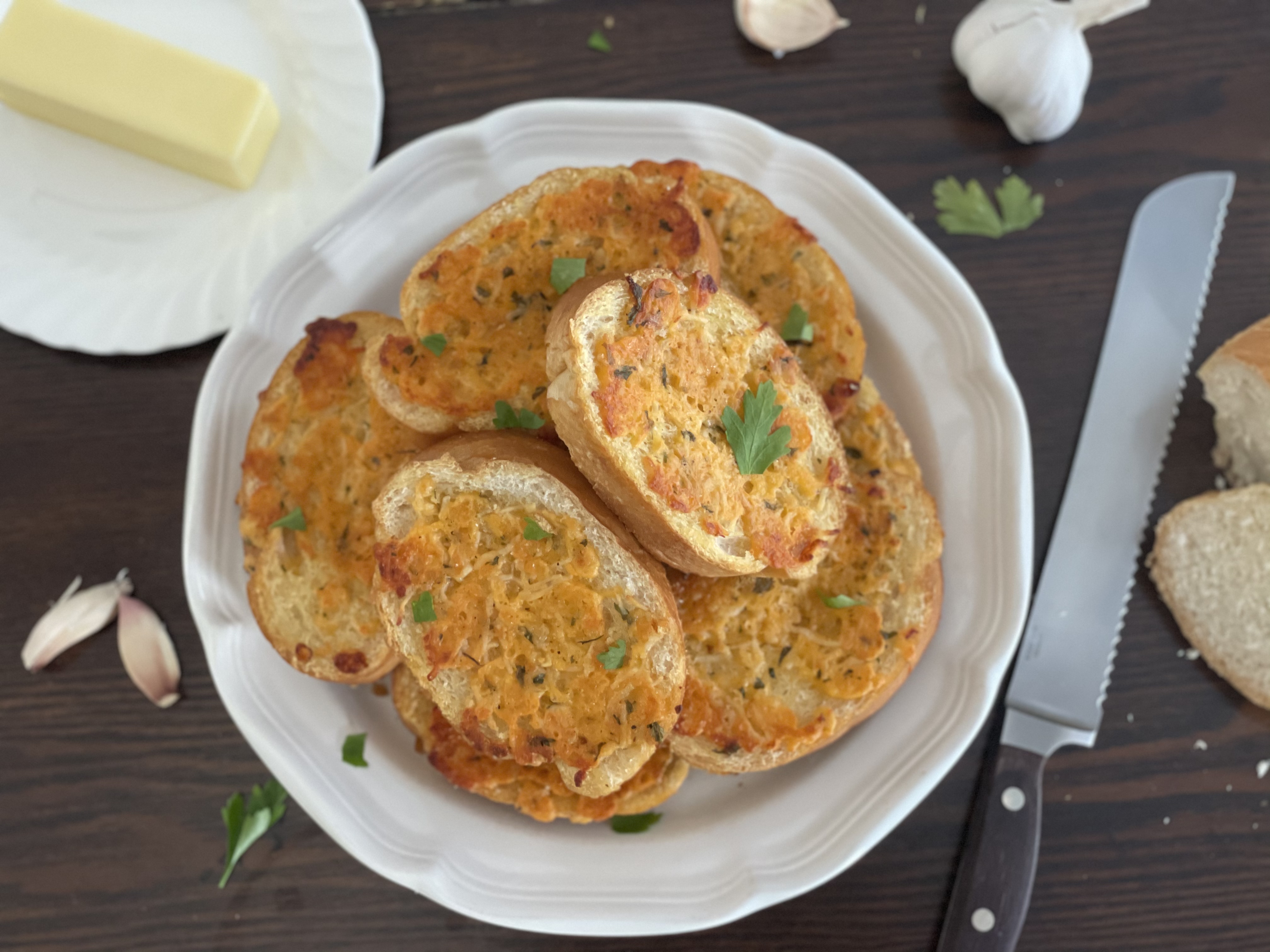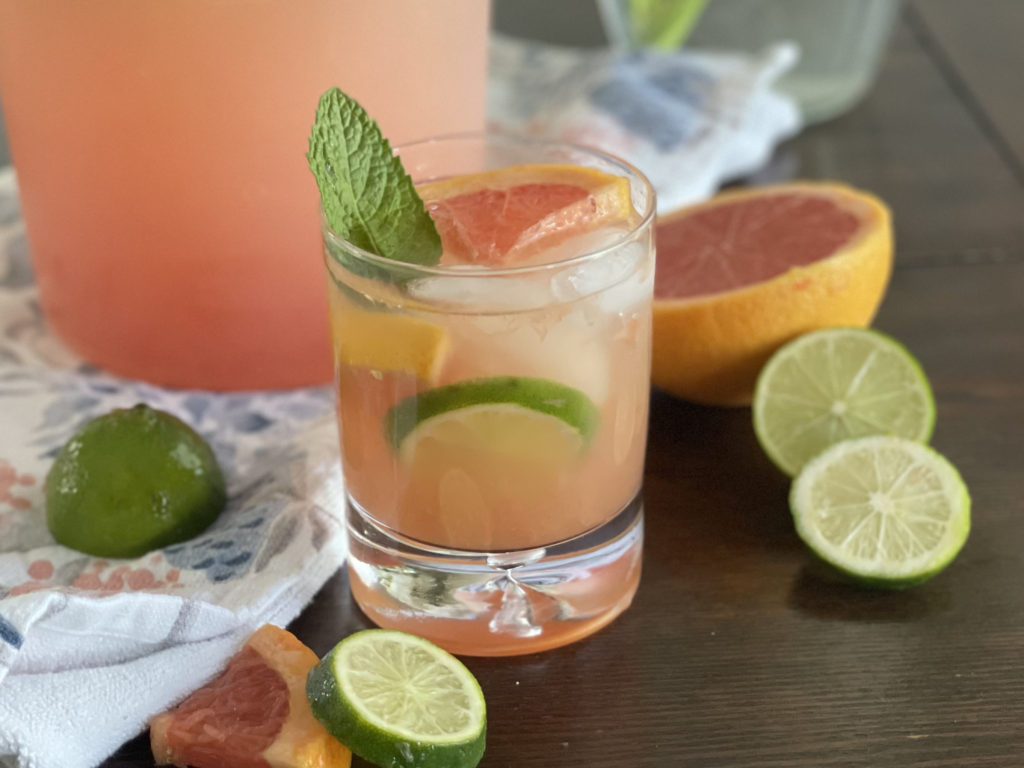Inspired by Texas

This meal couldn’t have been more perfect for our Memorial Day barbecue! I was in such a hurry to photograph the food so we could eat it that I didn’t realize how boring the full-meal shots were until now. I apologize to Texans for such plain photos, but it’s a compliment to your cuisine that all I could focus on was the food itself!
THE MEAL
(Click on the links above to jump to that part of the post!)
The largest state in the contiguous U.S. takes great pride in hard work, independence, and going big with everything they do. It probably doesn’t look it from the main picture of the food, but this meal took a lot of effort and patience and became a grand feast that I hope the Lone Star State would be proud of.
There were several things about this meal that were new to me to make myself, but I was really happy to find that it didn’t take many ingredients that I didn’t already have. Everything was available and familiar, yet it came together in a new, uniquely Texan way that we greatly enjoyed.
And as we were eating our Texas meal, I saw on Instagram that my Texan cousins were at an authentic Texas barbecue, and they were having the exact same food as us! Smoked brisket with pickles and onions. That was extremely validating. I know for sure that I made the right choice of foods this time around!

SMOKED BRISKET
Smoked brisket is one of the most popular foods in Texas. Texas has 12.5 MILLION cattle–the most of any state and 13% of the U.S.’s total cattle–so it made sense to me that beef would be a feature dish.
What I didn’t know, though, was that brisket was brought to Texas by Jewish immigrants. They had already been making brisket on special occasions as part of a kosher diet, but when they got to Texas and suddenly had an abundance of cheap beef, it became an extremely common offering at Jewish delis across the state. By the 1960s, most barbecue restaurants in Texas–not just the Jewish ones–were serving brisket. (Source)
I’ve eaten my share of brisket in the past, mostly thanks to the restaurant I worked at in college that served it sliced on its own or put in a sandwich. But the head chef was always in charge of the smoker, so I’d never made it myself. I was worried that using my dad’s Traeger was going to be more difficult than it was worth, but thankfully it was more simple than I expected, and the wait was well worth it!
This was also the most time I’ve ever spent making a non-bread food. It took 16 hours total!
I started by trimming down the fat. I think I got carried away and probably cut out too much of the fat on the lean side, but there was still plenty attached, and it didn’t turn out to be dry, thankfully. I used a dry rub of salt, pepper, paprika, granulated garlic, and cumin, and put the brisket in the smoker at 10:00 p.m. on the Saturday night before Memorial Day.
I slept fitfully, worried that something would go wrong with the smoker and I’d wake up to either a completely raw brisket or a completely scorched one. But no, the next morning, at 5:30 a.m., everything was fine and on track. I wrapped the brisket tightly in pink butcher paper (something I never knew existed before) and continued to smoke it until about 2:00 p.m. on Sunday, when I wrapped it in a towel and put it in a cooler to rest until dinnertime.
When we unwrapped that brisket right before dinner, we quickly put the dogs outside because they were salivating just as much as we were but didn’t have our self-control. I was legitimately worried that they would snatch it right off the table. It smelled AMAZING and tasted even better. Even though the Traeger did all the work, I felt so proud when the results of my patience were revealed.
The brisket could have been a little juicier if I hadn’t trimmed it too much, but it still passed the bend test, and it didn’t need any barbecue sauce to taste incredible. So tender! The rub was so simple yet gave the meat so much depth of flavor, not to mention the smoking itself. That one brisket fed 18 people and left a tiny bit left over, which I put on nachos the next day. Part of me wishes I could have made that brisket just for myself and had leftovers for the next month, but I love making meals for my family. Having everyone eat my brisket together was such a joy, and I’m sure Texans wouldn’t have it any other way.

HOMEMADE PICKLES
Pickles are commonly served alongside brisket as a free side at Texas restaurants. It’s said to have started when people would eat at shops that served barbecue and would buy ready-to-eat items on the shelves to go with it. Those items were most commonly pickles, onions, and white bread. (Source)
I love pickles, but I never realized how easy it is to make them yourself! When I saw how simple the recipes were, I decided to make my own instead of just grabbing a jar at the store.
Really all you need to do is make a brine of vinegar, water, sugar, salt, and pepper, then pour it into jars with sliced cucumbers, add some garlic and dill if desired, and let it sit for a while! Some recipes recommended eating them after only a half hour or so, but I let mine refrigerate for a whole day and a half, and that was much more to my liking. When first made, they just tasted like cucumbers in vinegar. When we served them the next day at dinner, they were distinctively pickley–crunchy, a little spicy, and delicious.
It was so simple and everyone liked them so much, I think I’m going to need to make them again sometime! My favorite are baby dills, so since I don’t grow cucumbers myself I’ll probably keep buying store-bought, but if I ever need pickle chips at a barbecue again, this recipe will do the trick nicely!
My only trouble with making pickles was finding a crinkle cutter. For some reason, they were sold out at all the major stores! I had to go to a local kitchen supply store to find one. I almost gave up, but I couldn’t resist making those classic wavy pickles. And now I have a crinkle cutter if I ever want to try making french fries again.
Oh, and I also served raw onion with the brisket along with the pickles. As mentioned before, they’re also commonly served with brisket in Texas, and the Texas sweet onion (aka “1015”) is Texas’s state vegetable. These were just plain red onions, not 1015s, but I had to include them as tribute!

TEXAS TOAST
Okay, Texans, I’m a little scared to write about this part of the meal, but I also have to get it off my chest. Hear me out and please give me your feedback in the comments:
People have been eating toast for centuries. Back in the day, when you wanted to toast up some bread, you put it on a griddle or in an oven or on a stick over an open flame.
Then the toaster was invented in 1893 to make the toasting process quicker and easier.
Then, in the 1940s, a cook named Wiley W. Cross couldn’t fit thick slices of bread into his toaster, so he said, “Wait, I have a crazy idea! I’ll toast them on the griddle!”
And everyone thought it was the most brilliant idea ever, and that’s how Texas toast was born. (Source)
Um….
Do you see the problem here?
First came the griddle, then came the toaster, then toasting the bread on a griddle again equals mind-blowing discovery?
Did I miss something??
Can someone PLEASE tell me what was so new and unique about this idea? I really fail to see how it warrants a claim of a new food invention.
I thought maybe it had to do with what you put on the toast, but no… All you need to make Texas toast is butter, garlic, salt, parsley–
Garlic bread.
It’s just garlic bread.
Right? Am I crazy? Someone please comment below to explain this to me! I feel like I’m going insane here.
So, I mean, yes, I loved Texas toast. You can’t really go wrong with white bread, garlic butter, and a little cheese added for good measure. Making lots of slices at once in the oven was ideal for feeding a crowd of people. It was really yummy, and I would make it again.
With spaghetti.
Because IT’S JUST GARLIC BREAD!!
Okay, I’m done. I’m so sorry.
Moving on!

SPARKLING GRAPEFRUIT JUICE
Did you know that grapefruits are a hybrid of sweet oranges and pummelos? They were brought from their native Barbados to the United States in the 1800s, starting in Florida and eventually making their way to Texas. In 1914, John H. Shary, “The Father of the Citrus Industry,” saw how well this relatively new fruit grew in Texas, and he turned it into a booming commercial crop. Red grapefruits were developed in the late 1920s, and they’re now Texas’s state fruit! (Source)
I considered just slicing up some grapefruit as a side, but then I learned about one of Texas’s favorite cocktails–the paloma. It’s basically just grapefruit juice, lime juice, and tequila. I don’t drink tequila, but the other ingredients sounded great, and I thought it was a nice way to incorporate the grapefruit.
I was going to serve Dr. Pepper with this meal, because it was invented in Waco, Texas, in 1885. But I drink Dr. Pepper all the time already (it’s my favorite soft drink–thank you, Texas!), so I went with the grapefruit juice idea instead.
It took a little experimentation to find the right combination of ingredients, but I eventually found a great ratio of grapefruit juice, lime juice, club soda, and sugar. Add a little mint, serve with ice, and you have a wonderfully refreshing drink for a summer barbecue!
It did take a lot of grapefruits to make enough for our party of 18, though. I went through an entire Costco bag just to get 4 cups of juice for about a 2-liter batch. Everyone got a taste, but it was gone really quickly. It’s definitely a better recipe for small groups, unless you use store-bought grapefruit juice, which is totally an option.
Anyway, I’m really fixated on this idea of making favorite mocktails for these state meals instead of whichever generic soda is most popular there. We’ll see how that pans out, but it worked great for this meal!

TEXAS SHEET CAKE
I debated for a long time which dessert to make for a Texas meal. Almost all the sources I found online said that the pecan pie is the most iconic Texas dessert. The pecan has been growing in Texas since prehistoric times and is Texas’s state nut and tree. It’s Texas’s only commercially grown nut. They LOVE their pecans. (Source)
But there were a couple places where I saw Texas sheet cake as a suggestion, and that idea firmly took root in my mind. For one thing, even though sheet cake is popular throughout the nation, it did most likely originate in Dallas, and Texans have a distinctive traditional way of making it using buttermilk and a stovetop glaze. Second, it still includes pecans. Third, I’d be feeding a crowd, and sheet cake would go a lot farther than a pie. And fourth…I just love chocolate better, sorry!
I took a poll on Instagram just to see how outraged people would be if I didn’t make a pecan pie, and 86% (including my Texan cousins) said that Texas sheet cake was okay, so I went with it!
As previously mentioned, nobody is positive about the origins of Texas sheet cake, but the oldest reference seems to be a recipe shared in a Dallas newspaper in 1957. Wherever it came from, it’s been wholeheartedly adopted by Texas! It’s especially popular at church functions and is sometimes called “Texas funeral cake” because it’s so common at potlucks after funerals. (Source)
You make a Texas sheet cake by creating a simple chocolatey cake batter and baking it in a thin layer on a large baking sheet or jelly roll pan. Nowadays, people use sour cream in the cake, but Texans traditionally use buttermilk, so that’s what I used. I probably could have added a little coffee to make it extra chocolatey, and there are a ton of other variations on the flavor, cinnamon being a common addition, but I just stuck with the basics.
When the cake is almost done baking, you make a chocolate glaze in a saucepan, add chopped pecans, and pour it over the cake when it’s still warm so the glaze really sinks in.
The result is a rich, decadent chocolate cake that’s about as big as Texas and perfect for feeding a crowd. If you’ve never made a Texas sheet cake before, I highly recommend that you do! It’s a winner for sure.

CONCLUSION
Nothing about this meal was especially unfamiliar to me, but it was my first time using a smoker, pickling cucumbers, and making a Texas sheet cake myself. While a little time-consuming, none of it was difficult to make, and most of the ingredients were simple and already on hand in my pantry! I love that about a meal.
In short, this meal was amazingly delicious. I loved every part of it and would easily make all these foods again. Thank you, Texas, for inspiring a wonderful meal!
So how’d I do? Let me know in the comments if you have any suggestions for improvement, and be sure to tune in next time for my take on a meal inspired by Oklahoma! If that’s where you’re from, what do you think I should make to represent your state? Bonus points if you have reliable recipes or pro tips before I make the attempt! Thank you for reading!
